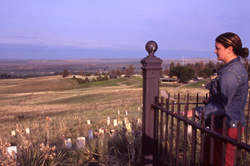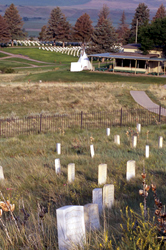Little Bighorn Battlefield
Updated: August 4, 2020

Located in southeastern Montana, Little Bighorn Battlefield National Monument memorializes the site of the Battle of the Little Bighorn which took place on June 25–26, 1876, between the United States Seventh Cavalry regiment led by Lt. Col. George Armstrong Custer, and the Sioux and Cheyenne.
No event in the history of the American West has been told in so many different ways as the Battle of the Little Bighorn. The mere names — Custer, Sitting Bull, Crazy Horse — evoke images and feelings that remain raw even 120 years after the fateful battle.

On Sunday June 25, 1876, hundreds of Sioux and Northern Cheyenne warriors converged on a ridge above the valley of the Little Bighorn to defeat Custer and 210 men of the United States Cavalry within an hour. In 1879 the site was designated the "Custer Battlefield" to honor the soldiers who had fought there. Finally, in 1992, after years of controversy, the site was renamed and rededicated as the Little Bighorn Battlefield, also recognizing the Native American warriors who fought in the fateful battle.
When President George Bush signed Public Law 102-201, which renamed the Battlefield (it used to be called the "Custer Battlefield"), he also designated 3,000 square feet for the construction of a living memorial dedicated specifically to those Indians who fought on either side of the Battle. Custer had some forty Crow and Arikara scouts working for him and several hundered Indians fighting against him. The design of the memorial is meant to foster "Peace Through Unity" and encourages an understanding between peoples of all races. Even folks who have visited the Battlefield in the past now have a reason to return.
Though the Little Bighorn Battlefield National Monument covers only 765 acres of federal lands, it lies in a region of Montana full of interesting and exciting sites to visit. The Battlefield itself is situated in the northern portion of the Crow Indian Reservation near Crow Agency, Montana. Another memorial, the Reno-Benteen Battlefield Memorial is dedicated to those soldiers under the command of Captains Benteen and Reno, who were meant to be at Custer's side during the Battle of Little Bighorn.
Crow people have a rich tradition of harmony with their lands. At the direction of Chief Plenty Coups, the Crow maintained peaceful relations with white settlers during the late 1800's while most of the Plains Indians were at war protecting their homelands. Chief Plenty Coups donated some of his peoples' land to the National Park Service in hopes that people of all races could enjoy this place of beauty together. The Chief Plenty Coups State Park is located 35 miles south of Billings, MT and just one mile west of Pryor. While there, you can tour a mock-up of the famous chief's lodge complete with authentic keepsakes.
On Saturday afternoons in August at the Chief Plenty Coups State Park you can experience Crow Traditional Lifeways. Crow people give presentations on Crow pipes and flutes, understaning the sweat lodge ceremony, tipi traditions, drumming and dancing, Crow beadwork, and uses of plants. They promise to be both fun and educational. If you can't make it to the Traditional Lifeways project, then show up on the first Saturday in September for the Day of Honor. Speakers and activities will commemerate Chief Plenty Coups and his non-violent philosophy.
On the third Saturday in August, the Crow Traditional Lifeways project will take a break so that everyone may attend Crow Fair. Beginning the third Thursday in August, Crow Agency becomes the "Tipi Capitol of the World." Crow Fair attracts over 10,000 Native Americans from all over North America. Though all people are welcome, Crow Fair is not a tourist attraction. It is the largest Northern Plains Indian celebration in the state and one of the largest in the country. With more than 800 white tipis set up, Crow Fair provides a chance for families and friends to gather together at least once each year. With drumming, dancing, and parades everyday, this colorful event could be the highlight of anyone's summer.
The Yellowstone Valley houses much history and natural beauty besides that associated with the Plains Indian Wars. The Bighorn Canyon National Recreation Area surrounds all of 77-mile long Bighorn Lake. This is a great place to camp, fish, hike, boat or enjoy the outdoors however you like. You can also view wildlife, visit Yellowtail Dam, or investigate Old Fort C.F. Smith. Adjacent to this recreation area, on the Montana/Wyoming border, lies the Pryor Mountains Wild Horse Range. High up in arid desert plains and mountain valleys, the Pryor Mountains Wild Horse Range was the first nationally designated area to provide a safe home for free-roaming wild horses. Today, around 120 wild horses live in this area together with bighorn sheep, mule deer, and other wildlife. Here, you can view big game animals in their natural habitat.
The Custer National Forest surrounds much of the Crow Indian Reservation. Rising from sea level to 12,799 feet. Granite Peak (Montana's highest point) the CNF covers over 1,000,000 acres of land. Petroglyphs, burial grounds, and magnificent scenery await exploration. The Little Bighorn Monument as well as the entire Yellowstone Valley would make an excellent side trip on the way to or from Yellowstone National Park, which is less than a day's drive away. Of course, you might choose to make Montana history an adventure all its own.
In the amphitheater area of the visitor center, visitors are treated to living-history contact stations as people dress and portray the characters of the past. They interpret the life of the native American of the plains, soldiers of the U.S. Cavalry, and Native American scouts of the 1870s. The presentations include discussion of the battle weapons and tactics used, as well as new interpretations of the infamous battle. Walking trails with interpretive markers allow visitors to reconstruct the events in their own minds.
Website: Little Bighorn Battlefield
Updated: August 4, 2020

